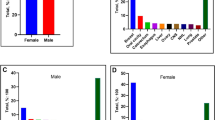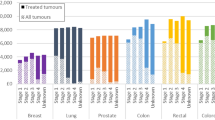Abstract
Purpose
Reducing time between cancer screening, diagnosis, and initiation of treatment is best achieved when services are available in the same hospital. Yet, comprehensive cancer centers are typically unavailable in low- and middle-income countries (LMICs), where resources are limited and services scattered. This study explored the impact of establishing an in-house pathology laboratory at the largest public cancer hospital in Tanzania on the downstaging of cervical cancer.
Methods
We examined clinical datasets of 8,322 cervical cancer patients treated at the Ocean Road Cancer Institute (ORCI). The first period included patients treated from 2002 to 2016, before establishment of the pathology laboratory at ORCI; the second period (post-pathology establishment) included data from 2017 to 2020. Logistic regression analysis evaluated the impact of the pathology laboratory on stage of cervical cancer diagnosis.
Results
Patients treated during the post-pathology period were more likely to be clinically diagnosed at earlier disease stages compared to patients in the pre-pathology period (pre-pathology population diagnosed at early disease stage: 44.08%; post-pathology population diagnosed at early disease stage: 59.38%, p < 0.001). After adjustment for age, region of residence, and place of biopsy, regression results showed patients diagnosed during the post-pathology period had higher odds of early stage cervical cancer diagnosis than patients in the pre-pathology period (OR 1.35, 95% CI (1.16, 1.57), p < 0.001).
Conclusions
Integrated and comprehensive cancer centers can overcome challenges in delivering expedited cervical cancer diagnosis and treatment. In-house pathology laboratories play an important role in facilitating timely diagnosis and rapid treatment of cervical and possibly other cancers in LMICs.

Source ORCI electronic medical records database, paper patient logbooks (2002–2011, n = 835); paper patient logbooks, paper medical records (2014–2018, n = 5,517); ORCI electronic medical records database, paper screening cards, paper pathology reports (2019–2020, n = 1,970)


Source Map built using “Your Free Templates” at: http://yourfreetemplates.com

Similar content being viewed by others
Data availability
The data that support the findings of this study are available from the Ocean Road Cancer Institute, but restrictions apply to the availability of these data, which were used under license for the current study, and so are not publicly available. Data are, however, available from the authors upon reasonable request and with permission of the Ocean Road Cancer Institute.
References
Hull R et al (2020) Cervical cancer in low- and middle-income countries (review). Oncol Lett 20(3):2058–2074
The Global Cancer Authority, and World Health Organization: International Agency for Research on Cancer (2021) Cervix uteri fact sheet. https://gco.iarc.fr/today/data/factsheets/cancers/23-Cervix-uteri-fact-sheet.pdf
World Health Organization (2014) Comprehensive cervical cancer control: a guide to essential practice. Geneva. https://apps.who.int/iris/bitstream/handle/10665/144785/9789241548953_eng.pdf;jsessionid=CC85198A90DD3DEB77A85835262F3751?sequence=1
World Health Organization: Information Center on HPV and International Agency for Research on Cancer (2021) Human papillomavirus and related cancers, Fact Sheet 2021, Tanzania. Barcelona. https://hpvcentre.net/statistics/reports/TZA_FS.pdf
World Health Organization (2020) Costing the national response to cervical cancer: United Republic of Tanzania, 2020–2024. Geneva. https://www.who.int/docs/default-source/cervical-cancer/tanzania-cxca-costing-report-20201113.pdf?sfvrsn=52df04eb_4
Devarapalli P et al (2018) Barriers affecting uptake of cervical cancer screening in low- and middle-income countries: a systematic review. Indian J Cancer 55(4):318
Gard AC et al (2014) Most women diagnosed with cervical cancer by a visual screening program in Tanzania completed treatment: evidence from a retrospective cohort study. BMC Public Health 14(1):910
Sachan PL, Singh M, Patel ML, Sachan R (2018) A study on cervical cancer screening using pap smear test and clinical correlation. Asia Pac J Oncol Nurs 5(3):337–341
Allanson ER, Schmeler KM (2021) Cervical cancer prevention in low- and middle-income countries. Clin Obstet Gynecol 64(3):501–518
Mattick LJC et al (2021) Downstaging of cervical cancer in Tanzania over a 16-year period. Cancer Causes Control 32(4):401–407
Runge AS, Bernstein ME, Lucas AN, Tewari KS (2019) Cervical cancer in Tanzania: a systematic review of current challenges in six domains. Gynecol Oncol Rep 29:40–47
Bobdey S, Sathwara J, Jain A, Balasubramaniam G (2016) Burden of cervical cancer and role of screening in India. Indian J Med Paediatr Oncol 37(04):278–285
Pimple S, Mishra G, Shastri S (2016) Global strategies for cervical cancer prevention. Curr Opin Obstet Gynecol 28(1):4–10
Bhatla N, Aoki D, Sharma DN, Sankaranarayanan R (2021) Cancer of the cervix uteri: 2021 update. Int J Gynecol Obstet 155(S1):28–44
Cherlin DS, Mwaiselage J, Msami K, Heisler Z, Young H, Cui X, Soliman AS (2022) Breast cancer screening in low-income countries: a new program for down-staging breast cancer in Tanzania. BioMed Res Int. https://doi.org/10.1155/2022/9795534
Ng’ida FD et al (2019) Knowledge and practices on breast cancer detection and associated challenges among women aged 35 years and above in Tanzania: a case in Morogoro Rural District. Breast Cancer 11:191–197
Bastani R, Robin Yabroff K, Myers RE, Glenn B (2004) Interventions to improve follow-up of abnormal findings in cancer screening. Cancer 101(S5):1188–1200
Kuupiel D, Bawontuo V, Mashamba-Thompson T (2017) Improving the accessibility and efficiency of point-of-care diagnostics services in low- and middle-income countries: lean and agile supply chain management. Diagnostics 7(4):58
Strother RM et al (2013) AMPATH-oncology: a model for comprehensive cancer care in Sub-Saharan Africa. J Cancer Policy 1(3–4):e42-48
Black E, Richmond R (2019) Improving early detection of breast cancer in Sub-Saharan Africa: why mammography may not be the way forward. Glob Health 15(1):3
Gospodarowicz M et al (2015) Cancer services and the comprehensive cancer center. In: Disease control priorities. Cancer, 3rd ed, vol 3. The World Bank, pp 195–210
Gurram L, Kalra B, Mahantshetty U (2020) Meeting the global need for radiation therapy in cervical cancer—an overview. Semin. Radiat. Oncol. 30(4):348–354
Habila MA et al (2021) Community-engaged approaches to cervical cancer prevention and control in Sub-saharan Africa: a scoping review. Front Global Women’s Health. https://doi.org/10.3389/fgwh.2021.697607
Koh W-J, Anderson BO, Carlson RW (2020) NCCN resource-stratified and harmonized guidelines: a paradigm for optimizing global cancer care. Cancer 126(S10):2416–2423
Pesec M, Sherertz T (2015) Global health from a cancer care perspective. Future Oncol 11(15):2235–2245
Sirohi B et al (2018) Developing institutions for cancer care in low-income and middle-income countries: from cancer units to comprehensive cancer centres. Lancet Oncol 19(8):e395-406
Haney K et al (2017) The role of affordable, point-of-care technologies for cancer care in low- and middle-income countries: a review and commentary. IEEE J Transl Eng Health Med 5:1–14
Snavely ME et al (2020) ‘If You Have No Money, You Might Die’: a qualitative study of sociocultural and health system barriers to care for decedent febrile inpatients in Northern Tanzania. Am J Trop Med Hyg 103(1):494–500
Gesink MP et al (2020) Quantifying the under-estimation of cervical cancer in remote regions of Tanzania. BMC Cancer 20(1):939
Sedani A et al (2019) Impact of initiating screening programs on referral and management of cervical cancer in Tanzania. J Glob Oncol. https://doi.org/10.1155/2022/9795534
Funding
Caroline Fuss was supported by the Cancer Epidemiology and Education in Special Populations (CEESP) Program through funding from the National Cancer Institute Grant R25CA112383 (PI: Amr Soliman, MD, PhD).
Author information
Authors and Affiliations
Corresponding author
Ethics declarations
Conflict of interest
The authors declare no conflicts of interests.
Ethical approval
Institutional Review Board approvals were obtained from George Washington University and by the Ocean Road Cancer Institute’s Academic, Research, Publications and Ethics Committee.
Additional information
Publisher's Note
Springer Nature remains neutral with regard to jurisdictional claims in published maps and institutional affiliations.
Rights and permissions
Springer Nature or its licensor (e.g. a society or other partner) holds exclusive rights to this article under a publishing agreement with the author(s) or other rightsholder(s); author self-archiving of the accepted manuscript version of this article is solely governed by the terms of such publishing agreement and applicable law.
About this article
Cite this article
Fuss, C.G., Msami, K., Kahesa, C. et al. The impact of in-house pathology services on downstaging cervical cancer in Tanzania over an 18-year period. Cancer Causes Control 35, 93–101 (2024). https://doi.org/10.1007/s10552-023-01768-x
Received:
Accepted:
Published:
Issue Date:
DOI: https://doi.org/10.1007/s10552-023-01768-x




